
Image source: https://flic.kr/p/99hH5o, under Creative Commons License
Many countries have regulations concerning paid time off (time cockpit uses the term vacation for that). In our home country Austria for instance, employees typically have five weeks of paid vacation. On first sight, calculating the remaining paid vacation should not be too hard. However, if you dig into the details and edge cases, it gets interesting.
Integrated Time Tracking and Vacation Management
Before we start looking at various examples, we have to recall that time cockpit has a single, integrated calculation logic for
- planned hours of work,
- overtime, and
- vacations.
Entering vacations in time cockpit automatically reduces the planned hours of work. This reduction is also taken into account during overtime calculation. Therefore, time cockpit needs to convert a day of vacation into the corresponding number of hours by which the planned hours of work have to be reduced.
This integrated calculation logic is important to make sure that time cockpit customers do not have to enter data in separate modules multiple times.
The Simple Case
Let’s start with a first, simple example. We assume you have an employee who has to work for 7.7 hours five days per week. This results in a total of 38.5 planned hours of work. This is how it looks in time cockpit:
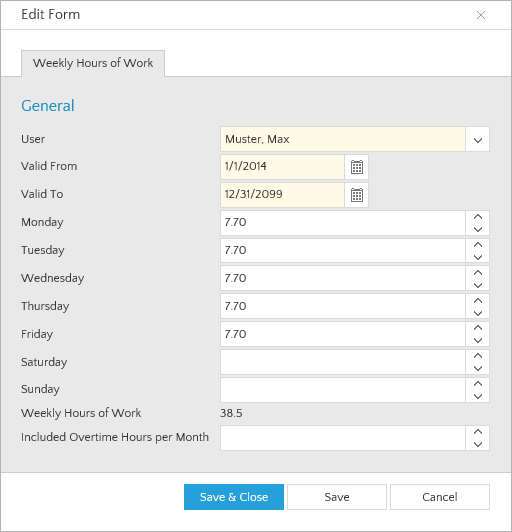
Note that the screenshots have been created using time cockpit’s new HTML5 client.
Let’s also assume that the employee is entitled to get five weeks of paid vacation.
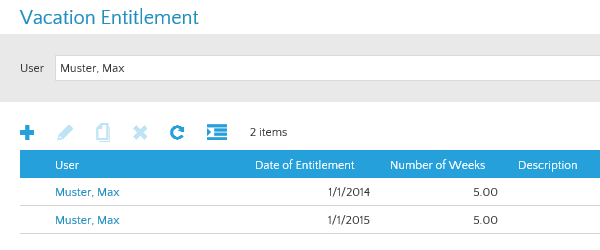
In that case the vacation entitlement can easily be converted to 5 * 5 = 25 days or 25 * 7.7 = 192.5 hours. Each vacation day reduces the remaining vacation by one day = 7.7 hours. We can also convert days to weeks by dividing the number of days by five. One day off becomes 0.2 weeks. You might wonder why we care about converting days to weeks and vice versa at all. This conversion logic will become very important when we discuss more complex cases.
Here is the result of a two-week holiday in time cockpit:

So far, so good.
Part-Time Employees with Equally Distributed Working Hours
When it comes to part-time employees, time cockpit needs to know the days on which the employees work. If such employees work five days per week (e.g. every morning for four hours), holidays can be handled just like in the simple case described above.
However, if an employee works e.g. only two days, time cockpit needs to know on which days in order to correctly handle legal holidays (e.g. national holidays).
For an employee who works e.g. Monday and Tuesday, a legal holiday on Wednesday would not be relevant. A day off is only reducing the amount of remaining vacation if it is a working day for the corresponding employee.
Here you see how you could enter the planned working time per weekday for a part-time employee in time cockpit:
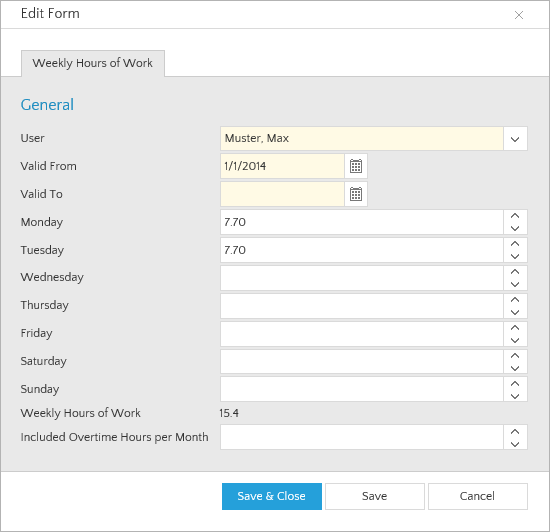
In the case of part-time employees with equally distributed working hours, remaining vacation days in weeks can be converted to remaining days using the following formula:

Part-Time Employees with Unequally Distributed Working Hours
Let us raise the bar and add a bit of complexity. Assume we have an employee who works full-day on Monday and half-day on Tuesday and Wednesday:
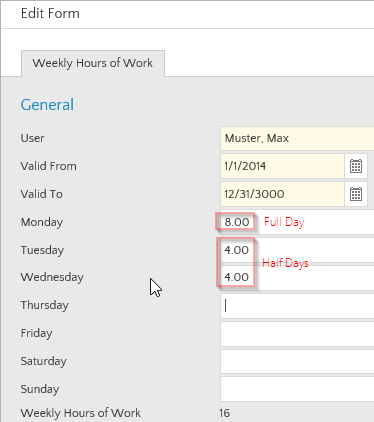
Now it matters on which day an employee takes her vacation. We can no longer convert days to weeks by simply dividing it by the number of working days, because the working hours are not equally distributed over the working days anymore.
The following example demonstrates this for the planned working time shown above. Note that taking Monday off reduces the remaining holidays by half a week (8 / 16 = 0.5) while Tuesdays result in only a quarter of a week (4 / 16 = 0.25).
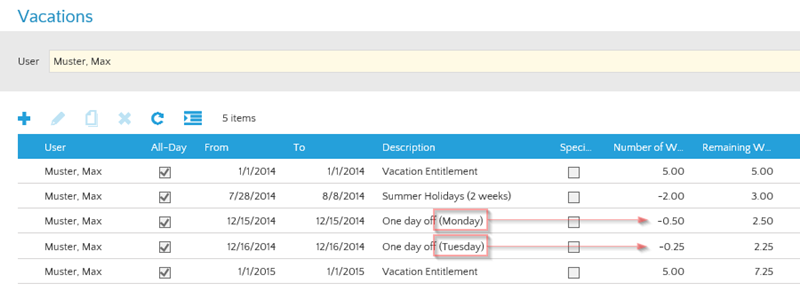
Customers frequently ask us why we do not simple calculate the average working hours per working day and use that for converting vacation days into working hours. Let’s think this idea through based on the example shown above. The employee works in total 16 hours per week = on average 5.33 hours per working day. On Monday, using the average would be unfair for the employer as the average is lower than the real working time. On Tuesday and Wednesday, the situation would be unfair for the employee as the average is higher.
As you can see, calculating remaining holidays becomes much more complex in cases of unequally distributed working time. Reducing remaining holidays by a fixed number of hours independent of the weekday would always be unfair, sometimes for the employer and sometimes for the employee.
The internet is full of discussions of employees complaining about employers who calculate using average working hours per day. Many state that they consciously take vacation on long working days because they find this practice unfair. We want to avoid that conflict and therefore time cockpit is capable of calculating it correctly.
Changes in Employment Relationships
Over time, employment relationships sometimes change. An employee might start as an intern working only a few hours per week. After finishing school, the employment might change to a full-time contract. After a few years, the employee might get children and want to stay at home for a few days each week. You get the idea.
The question is how to handle remaining vacation in cases of such changes.
The most common solution that time cockpit uses too, is to generally calculate remaining vacations in weeks instead of days.
Let’s take a look at an example of an employee who changed to part-time during parental leave:

Regarding time cockpit, we often get asked why we always show remaining vacation in weeks. This sample demonstrates why calculating in days would be possible but quite confusing.
Staying at home an entire week has to reduce the remaining vacation by one week, independent of employment relationship changes.
Otherwise an employee changing from full-time to part-time or vice versa would massively raise or reduce the remaining paid time off.
Let’s look at the remaining holiday calculation in time cockpit for that example:

Note that by calculating based on weeks, the calculation stays consistent although the employment relationship changes. An absent week stays a week independent of the planned number of working hours.
Calculating Vacations in Days
Frequently we get the request to display the vacation numbers in days. As time cockpit is highly configurable, it is possible to customize time cockpit this way. However, we have decided to stick to week-based numbers as days are somewhat misleading. Let’s look at an example that demonstrates this.
Imagine we would add remaining vacation days to the previous table. It would look like this:

Note that 4 remaining weeks correspond to 20 days in March as the employee works five days per week. In August, 2 weeks correspond to 6 days as the employee’s employment relationship changed to three working days per week. Therefore, it looks like the employee has “lost” 14 vacation days although she only was two weeks = 10 days away.
It would get worse if the employee would have unequally distributed working hours (like in the sample above with 8 hours on Monday and 4 hours on Tuesday and Wednesday). Imagine the employee has one vacation week left, how many days are that? Two days if the employee stays at home on two Mondays but four days if she takes off on Tuesdays or Wednesdays. For customers who insist on displaying days, we calculate with average working hours per day knowing that this is not perfectly correct.
Such situations regularly lead to confusion. We think that displaying vacation based on weeks is much clearer and easier to understand.
Conclusion
Calculating paid holidays is not always simple. Part-time employments and changes of the employment relationship lead to complex calculations. Time cockpit can handle even the complex edge cases.
Because of the integrated calculation engine for planned hours of work, overtime, and vacations, time cockpit internally calculates in hours and displays vacation numbers in weeks. However, the uniqueness of time cockpit comes from its customizability. If you absolutely need to display vacation numbers in days e.g. because your employees are used to it, contact us. We can help you tailoring lists and reports to your specific needs.
comments powered by